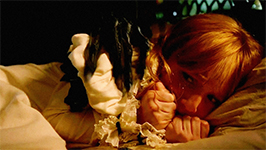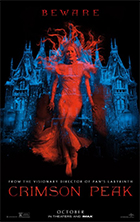Crimson Peak
|  Guillermo del Toro’s grandiose Gothic romance Crimson Peak is an impressive, overripe cinematic feat that makes up for its somewhat pedestrian plotting with a stunning visual imagination that impresses in both the scope and detail with which it merges so many of del Toro’s cultural obsessions—Romantic art, Hammer horror films, Italian giallo, Gothic literature. It marks del Toro’s return to supernatural horror, which he last visited in 2006 with the magnificently creepy Pan’s Labyrinth. Unlike that film and The Devil’s Backbone (2001), his only other ghost film, Crimson Peak does not have an expressly political backdrop (both of those films were set against the Spanish Civil War), but instead plays as a kind of Gothic 101 primer: Crumbling medieval manor that symbolizes the decay of the decadent past its conflict with the present? Check! Predatory villain? Check! Female protagonist? Check! Supernatural presence? Check! Del Toro has never been one to back down from self-aware allusions in his film, and Crimson Peak may very well be his most overtly self-aware to date, which means that how much pleasure you derive from it will likely be directly correlated with how your cultural fascinations match up with del Toro’s. Guillermo del Toro’s grandiose Gothic romance Crimson Peak is an impressive, overripe cinematic feat that makes up for its somewhat pedestrian plotting with a stunning visual imagination that impresses in both the scope and detail with which it merges so many of del Toro’s cultural obsessions—Romantic art, Hammer horror films, Italian giallo, Gothic literature. It marks del Toro’s return to supernatural horror, which he last visited in 2006 with the magnificently creepy Pan’s Labyrinth. Unlike that film and The Devil’s Backbone (2001), his only other ghost film, Crimson Peak does not have an expressly political backdrop (both of those films were set against the Spanish Civil War), but instead plays as a kind of Gothic 101 primer: Crumbling medieval manor that symbolizes the decay of the decadent past its conflict with the present? Check! Predatory villain? Check! Female protagonist? Check! Supernatural presence? Check! Del Toro has never been one to back down from self-aware allusions in his film, and Crimson Peak may very well be his most overtly self-aware to date, which means that how much pleasure you derive from it will likely be directly correlated with how your cultural fascinations match up with del Toro’s.The film opens in Boston at the turn of the 20th century where we meet the protagonist, Edith Cushing (Mia Wasikowska), the bookish and fiercely independent daughter of Carter Cushing (Jim Beaver), a wealthy, self-made industrialist. Edith nurtures dreams of becoming a novelist in the vein of Mary Shelley, although she constantly finds that her being a woman impedes her being taken seriously by publishers (at one point she types her manuscript because her feminine handwriting is a dead giveaway). She shows little interest in romance or getting married, and she is incensed when a publisher paternalistically suggests that she would be better off writing a conventional romance rather than the ghost-infested Gothic story she has concocted (“The ghosts are metaphors,” she insists, a line that is clearly a clue as to how we should view Crimson Peak, as well). Edith’s life takes a turn when she meets Sir Thomas Sharpe (Tom Hiddleston), a handsome young Englishman who arrives at her father’s office looking for investment in a proposed contraption that he will use to mine valuable red clay from the grounds of his family’s estate. Through a series of plot machinations Edith and Thomas end up falling in love and she marries him and leaves her life in America behind —including her could-be-more-than friendship with a local doctor, Alan McMichael (Charlie Hunnam)—to live with him at Allerdale Hall, the once prosperous Sharpe family’s enormous, crumbling manor. Also living with them is Lady Lucille Sharpe (Jessica Chastain), Thomas’s icy older sister whose maternal protectiveness of Thomas and bristling at Edith’s presence suggests that some kind of perversity is lying beneath her and her brother’s relationship. The binding theme in the film, as in most Gothic literature, is rot—literal, emotional, and metaphorical—and Crimson Peak is filled with it. Allerdale Hall, which sits on a frozen, treeless expanse of land that seems completely removed from the rest of the world, is a beautiful-horrible study in decay. The central turret has collapsed, leaving the middle of the house exposed to the frigid elements, while the various rooms exude a sense of menacing medieval design that we can imagine was once impressive but is now primarily rusted and tarnished and dusty. The idea of the manor sitting atop a deep bed of red clay offers an almost too-perfect visual metaphor for the moral rot on which the Sharpe family resides: It causes the water in the pipes to run like blood when faucets are first turned on; it runs in goopy streams down the walls of the basement, making the cavernous space look like the literal guts of the house; and it eventually stains the snow around the manor, giving it the visual appearance of sitting atop an enormous, festering wound. And then there are the ghosts, which first appear in the film’s opening scene and appear sporadically throughout the film, usually to impart a dire warning to Edith. “It’s not a ghost story; it’s a story with ghosts in it,” Edith describes her own story at one point, which again is a none-too-subtle clue as to how we should understand Crimson Peak and its spectral bodies. Similar to the ghost in The Devil’s Backbone, del Toro imagines the film’s spirits as liminal beings that have a real sense of physicality to them even as they are clearly apparitions. Some are more skeletal than others, while some look like gelatinous, rotting corpses, but all of them bear the scars of violence, which del Toro depicts as constantly emanating clouds of blood that float from their bodies as if they are immersed in water. The images are suitably terrifying and they leave a strong impression, even when they are absent from the screen for long periods of time. As should be clear, the real star of the film is del Toro’s visual sensibility, which is fully realized in all its sumptuous glory by production designer Thomas E. Sanders (whose first project was Francis Ford Coppola’s similarly opulent love letter to the horror cinema’s past, 1992’s Bram Stoker’s Dracula) and Danish cinematographer Dan Laustsen (Silent Hill, The Brotherhood of the Wolf). The enormity and physical detail of the rotting manor could keep one’s eyeballs enthralled for hours alone, and Laustsen lights and composes the visuals in the overwrought, heavily saturated style of Mario Bava and Dario Argento and moves the camera with a classical grace. The screenplay by del Toro and Matthew Robbins (who co-wrote and directed the grim early ’80s fantasy epic Dragonslayer and co-wrote del Toro’s first Hollywood foray, 1997’s Mimic) hits all the right notes and covers all its bases without ever really elevating the story to the level of the visuals, but the film works anyway because the images have such a powerful force of their own. Mia Wasikowska, who was so dull in Tim Burton’s Alice in Wonderland (2010) and so dynamic and rich in Chan-wook Park’s Stoker (2013), manages to hold the center of the film admirably. Tom Hiddleston has the difficult job of portraying a sense of normality while also suggesting that something is amiss, while Jessica Chastain gets to fully indulge her inner Mrs. Danvers—all coiled rage and repressed desire. Their characters never really emerge beyond types, but they have just enough personality to stand out from their surroundings and engage us emotionally, if only through familiar tropes that del Toro executes with such passion that you can’t help but get caught up in his fervor. Copyright ©2015 James Kendrick Thoughts? E-mail James Kendrick All images copyright © Universal Pictures |
Overall Rating: 


 (3.5)
(3.5)


